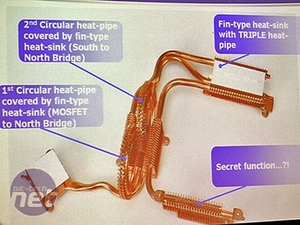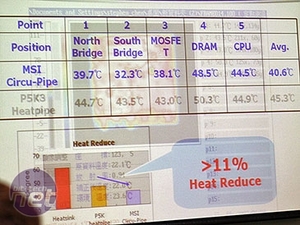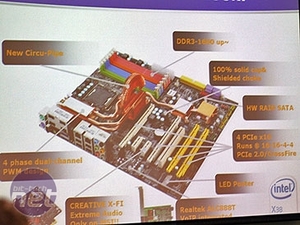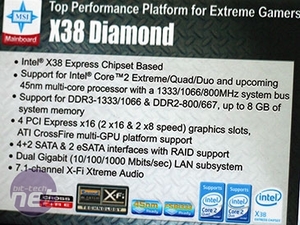
After bringing you a sneak peak last month, MSI has given bit-tech final details on its upcoming X38 Diamond motherboard today in Shanghai.
First off - the design hasn't changed much since you saw it last but now we have pictures of the full CircuPipe array. Compared to the P35 Platinum's and P35 Diamond's double pipe array, it's a little meatier but only contains a single loop.
The design of the dual loop P35 boards did offer a (claimed) 11 percent temperature drop over the heatpipes on Asus' P5K motherboards but there's no special liquid inside. Instead, they're just a typical set of heatpipes morphed in a rather unique manner.
We asked what the "secret function" of the P35 heatpipes was (see picture below), considering they are now missing from the X38's CircuPipe. I had expected something, anything fancy, like having motherboard traces from the CPU area to duct the heat towards it.
In reality though, it's simply an increase of surface area to catch air from the CPU fan, case fans and memory fan (who actually uses one of those?) to cool a little better. I see MSI's point, however some would argue it further restricts the space around the CPU socket - thankfully, that's not a problem on the X38.
For watercooling nuts, you will be glad to hear MSI has a limited edition watercooling option in the works, but no timescale was given for release. Push pins are still used to hold everything down (sigh), although MSI does realise the need for proper bolts. Of course, the company will still wait until they are required in future products for better heatsink contact.
There's a PCI-Express X-Fi card thrown in too (that you can use in any x1 slot!) as well as the Realtek ALC888T HD Audio chipset for use with the included Skype daughterboard. There are six DIMM slots, of which two are DDR2 and four DDR3 which should make upgrading a little less painless. The dual Gigabit Ethernet is handled by your usual PCI-Express Realtek chipset for one port, but this time MSI has gone for the more expensive (and better performing) Intel Gigabit chipset to complement it.
Like the rest of the Platinum and Diamond boards, this one contains 100 percent Japanese solid state capacitors, but they are still DIP and not SMD like the ones Gigabyte uses. MSI doesn't believe that it makes a difference in overall board temperature after doing thermal testing, though it does acknowledge that the loss of board life is likely a quite significant two years when using DIP caps instead.
Of course, that's after the board has survived for at least eight years already. By that time, the expectant upgrade cycle for the vast majority will have come and gone, making SMD caps an unnecessary expense. And we can now say that after a tour of the manufacturing facilities here in Kushan, these caps are still installed by hand rather than machine which we highly suspect Gigabyte uses. There will be more on that in a later article.
First off - the design hasn't changed much since you saw it last but now we have pictures of the full CircuPipe array. Compared to the P35 Platinum's and P35 Diamond's double pipe array, it's a little meatier but only contains a single loop.
The design of the dual loop P35 boards did offer a (claimed) 11 percent temperature drop over the heatpipes on Asus' P5K motherboards but there's no special liquid inside. Instead, they're just a typical set of heatpipes morphed in a rather unique manner.
We asked what the "secret function" of the P35 heatpipes was (see picture below), considering they are now missing from the X38's CircuPipe. I had expected something, anything fancy, like having motherboard traces from the CPU area to duct the heat towards it.
In reality though, it's simply an increase of surface area to catch air from the CPU fan, case fans and memory fan (who actually uses one of those?) to cool a little better. I see MSI's point, however some would argue it further restricts the space around the CPU socket - thankfully, that's not a problem on the X38.
For watercooling nuts, you will be glad to hear MSI has a limited edition watercooling option in the works, but no timescale was given for release. Push pins are still used to hold everything down (sigh), although MSI does realise the need for proper bolts. Of course, the company will still wait until they are required in future products for better heatsink contact.
There's a PCI-Express X-Fi card thrown in too (that you can use in any x1 slot!) as well as the Realtek ALC888T HD Audio chipset for use with the included Skype daughterboard. There are six DIMM slots, of which two are DDR2 and four DDR3 which should make upgrading a little less painless. The dual Gigabit Ethernet is handled by your usual PCI-Express Realtek chipset for one port, but this time MSI has gone for the more expensive (and better performing) Intel Gigabit chipset to complement it.
Like the rest of the Platinum and Diamond boards, this one contains 100 percent Japanese solid state capacitors, but they are still DIP and not SMD like the ones Gigabyte uses. MSI doesn't believe that it makes a difference in overall board temperature after doing thermal testing, though it does acknowledge that the loss of board life is likely a quite significant two years when using DIP caps instead.
Of course, that's after the board has survived for at least eight years already. By that time, the expectant upgrade cycle for the vast majority will have come and gone, making SMD caps an unnecessary expense. And we can now say that after a tour of the manufacturing facilities here in Kushan, these caps are still installed by hand rather than machine which we highly suspect Gigabyte uses. There will be more on that in a later article.

MSI MPG Velox 100R Chassis Review
October 14 2021 | 15:04












Want to comment? Please log in.